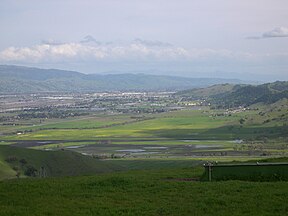By: Isabelle Marmur
 |
| Coyote Valley |
The area of Coyote Valley is composed of 7,200 acres of farmland, but instead of a push for farmers by the city of San Jose, the intention has been to develop the area into a new city, according to Sibella Kraus, a developer of sustainable agriculture, marketing, and education in the San Francisco Bay Area. Instead of urban development, the developers in the area of the Coyote Valley have not begun building yet, making it still available to purchase and use as farmland.
Kraus is the president of Sustainable Agriculture Education (SAGE), a nonprofit organization that supports regional food systems and multifunctional agriculture. SAGE is currently working towards a solution in the Coyote Valley.
Within the Coyote Valley there is a 348-acre reserve which SAGE is attempting to gain for local and sustainable agriculture. “One main challenge is putting that land back in the hands of the people that farm, and that needs to happen in a systematic kind of way,” said Kraus.
The project consists of five goals: increasing the number of specialty crop operations, increasing specialty crop acreage and profitability, enhancing natural resource conservancy by adopting new sustainable land practices and establishing habitat enhancement, increasing agri-tourism, and increasing sales of CV-grown specialty crops to local markets, including on-farm sales, according to SAGE.
“The [Coyote Valley] land prices are high,” said Kraus. If SAGE or local farmers wish to acquire land, they would need funding, as developers have more resources than nonprofits and local farmers. “Farming doesn’t work where you have a parcel here and a parcel there; it needs to be developed and the infrastructure developed,” said Kraus.
Developers have only begun to obtain the land of the Coyote Valley within the last few years, quickly removing the option of local farming. In addition to new development, the city of San Jose has designated part of the northern area for campus industrial farming, according to Kraus.
The Coyote Valley is desirable land for multiple reasons. “There is market demand. There is money to be made by developers when they come and put in new developments,” said Kraus.
The suburban aspects of the land that resides just south of the hustle and bustle of San Jose are a staple of American culture and the American dream, especially in California. “For a city to be growing, it has to be growing geographically,” said Kraus.
There has been a long period of time in which the definition of cities growing meant for the inhabitants to sprawl throughout the area as opposed to simply growing in population, diversity, or economically, according to Kraus.
The city of San Jose is facing the predicament of what to do with the area. Creating an urban area would allow for mass revenue, but they would lose the opportunity to accumulate additional sustainable farming.
At the moment, the majority of the land is not being used. It has not yet been converted into an urban area, but developers still own the land that is not currently being used.
There’s no telling the future of the Coyote Valley land and how it will be used, but SAGE is hopeful for a success for local farmers and sustainable agriculture. A major accomplishment for SAGE would be if the small piece of land on the edge of the San Jose border is converted into sustainable farms instead of a hub for urban development.
No comments:
Post a Comment